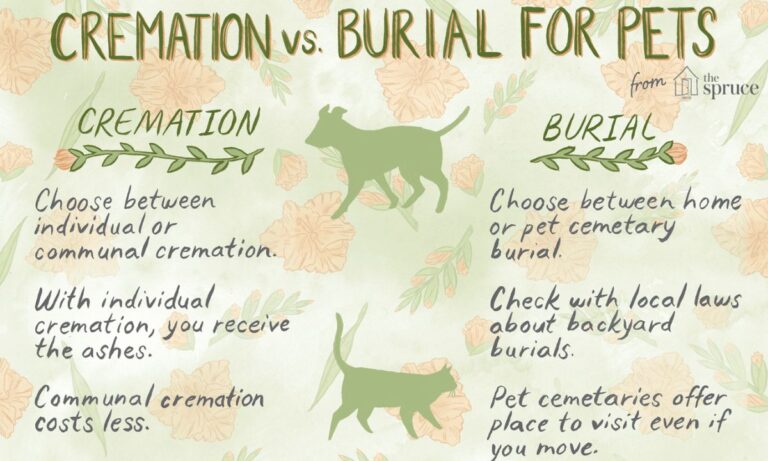The death of a pet can be a devastating experience. Whether it happens suddenly or after a prolonged illness, knowing what to do when your pet dies at home is crucial. Handling the situation properly can help you navigate
Through the sadness and ensure that your pet is treated with dignity in their final moments. This guide will walk you through what happens when a pet dies naturally, your options for handling the body, and how to memorialize your beloved companion.
What Happens When a Pet Dies Naturally?
When a pet passes away naturally, it typically happens either peacefully in their sleep or following a prolonged illness. The body undergoes certain changes. Respiratory function ceases, and blood circulation stops. Eventually, the body will begin to cool and stiffen in a process called rigor mortis.
It’s important to confirm that the pet is truly deceased. Sometimes, pets may enter a coma-like state due to illness, and a simple check for signs of life can help clarify the situation. If you’re unsure, it’s best to contact a veterinarian.
What to Do When Your Cat or Dog Dies

When your pet dies at home, it’s essential to stay calm and follow a few key steps. First, ensure the pet is truly gone by checking for signs of life. You can gently touch their chest to feel for a heartbeat or look for breathing. If you confirm they’ve passed, handle the situation with care.
Next, you’ll need to decide what to do with their body. Many pet owners choose to either bury or cremate their pet. Some pet cemeteries offer burial services, while others may assist with cremation. Ensure you’re aware of any local regulations regarding the disposal of pets’ remains in your area.
Dealing with a Cat or Dog Death: The Options
Dealing with your pet’s death can be emotional, and it’s essential to make decisions that reflect your feelings. Here are a few options for what to do next:
- Home burial: If local regulations allow, you might choose to bury your pet at home. This gives you a physical place to visit and remember them.
- Pet cremation: Many owners opt for cremation, which can provide the option for keeping their pet’s ashes in a memorial urn.
- Pet cemetery: Some prefer a formal burial or a headstone in a pet cemetery, where the remains are respectfully handled.
Each option provides a way to honor your pet’s life in a way that feels most comfortable to you.
Read This Blog; How Much Is a Pet Snake
Pet Cremation
Cremation is one of the most common methods for handling a pet’s remains. This option can be more flexible and accessible than burial, specially for apartment dwellers or those who may not have a suitable burial spot.
- There are two main types of pet cremation
- Individual cremation: The pet is cremated alone, and the ashes are returned to you.
- Communal cremation: Multiple pets are cremated together, and the ashes are not returned.
- Some cremation services offer extra features like the creation of paw print keepsakes or the option to have a ceremonial cremation.
How Much Does It Cost to Cremate a Dog or Cat?
The cost of cremating a pet can vary depending on your location, the size of your pet, and the type of cremation you choose. On average, pet cremation costs between $50 to $300. Here’s a breakdown of potential costs:
| Type of Cremation | Average Cost |
| Individual cremation | $100 – $300 |
| Communal cremation | $50 – $150 |
| Pet urn | $20 – $200+ |
| Additional services (paw prints, etc.) | $20 – $100+ |
Prices may vary based on the pet’s size. Larger pets often cost more to cremate due to the additional time and materials required.
Create a Memorial After the Loss of a Pet
Creating a memorial for your pet can help you honor their life and celebrate the time you shared. There are many ways to do this, including:
- Custom memorials: Some pet owners opt for custom headstones or engraved plaques with their pet’s name and important dates.
- Memorial jewelry: You can have a piece of jewelry created with a paw print or a small portion of your pet’s cremated remains.
- Pet portrait: Commissioning a portrait or creating a photo album can provide a lasting memory of your pet.
These memorials allow you to keep your pet close to your heart long after they’re gone.
Share Your Feelings
Losing a pet can be as emotionally intense as losing a family member. It’s important to give yourself time to grieve. Don’t be afraid to talk to others about how you’re feeling. Sharing your memories and emotions can help you process the grief.
Consider reaching out to friends or family members who understand your loss. Pet loss support groups or counseling services can also provide valuable assistance in navigating your grief.
Read This Blog; Can You Have a Wombat as a Pet in Australia?
Support When You Need It
Grieving the loss of a pet is a personal journey, and it’s important to reach out for help when needed. Support comes in many forms, including:
- Pet loss hotlines: Many organizations offer hotlines where you can speak to a counselor trained to support grieving pet owners.
- Support groups: Online or local groups can connect you with others who understand what you’re going through.
- Therapists: Some counselors specialize in pet loss grief and can guide you through the mourning process.
Don’t hesitate to seek help if you’re struggling with your emotions. A supportive community can make a significant difference during this difficult time.
When to Get a New Pet

After the death of a pet, many owners feel the desire to get a new companion. However, it’s essential to give yourself time to grieve properly before making this decision. Getting a new pet too soon can sometimes interfere with the healing process.
There is no set timeline for when it’s “right” to adopt a new pet. Only you can determine when you’re ready to open your heart to a new animal. When you feel emotionally ready and have thought carefully about the responsibilities involved, adopting a new pet can help bring joy back into your life.
Featured Products
Here are a few products that may help you after the loss of a pet:
- Pet urns: A respectful way to keep your pet’s ashes. Choose from a wide range of materials and designs.
- Memorial jewelry: Keep your pet close with jewelry that incorporates a portion of their ashes or a paw print.
- Pet portrait: Commission a beautiful custom painting or print to remember your pet’s face.
- Pet loss books: Some helpful books can guide you through the grieving process and help you heal.
Frequently Asked Questions (FAQs)
What should I do if my pet dies at home?
Make sure your pet has passed by checking for signs of life. You can then choose between burying or cremating your pet. Contact your veterinarian for guidance.
How can I memorialize my pet?
You can create a memorial by ordering an urn, creating a paw print, or commissioning a portrait. Other ideas include memorial jewelry or a photo album.
Can I cremate my pet at home?
No, it’s not recommended to cremate pets at home due to legal and safety reasons. It’s best to contact a professional pet cremation service.
How long should I wait to get a new pet after losing one?
There’s no set time. It’s essential to give yourself time to grieve and ensure you’re emotionally ready to welcome a new companion into your life.
Is there a support group for pet loss?
Yes, there are many pet loss support groups available both online and in person. They can help you connect with others who understand the pain of losing a pet.
Conclusion
Losing a pet is a heartbreaking experience that can leave you feeling lost and overwhelmed. However, by taking thoughtful steps after your pet’s death, such as deciding on cremation, creating a memorial, and seeking support, you can begin to heal. Remember, there’s no right or wrong way to grieve, and it’s important to honor your pet in the way that feels best for you.
When you’re ready, you may find comfort in adopting a new pet. Until then, cherish the memories of the time you spent together, as your pet will always have a place in your heart.
